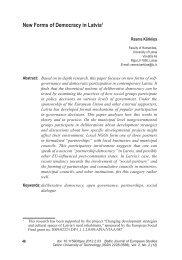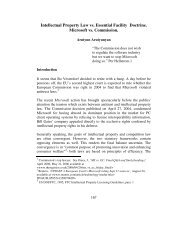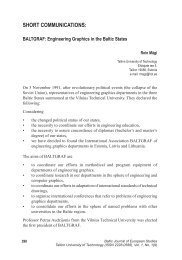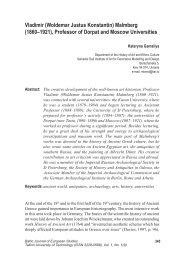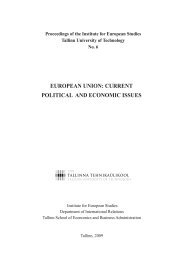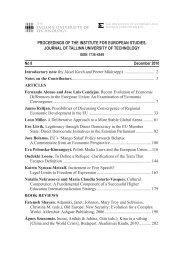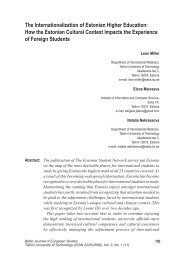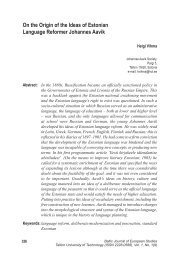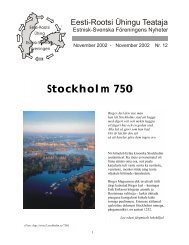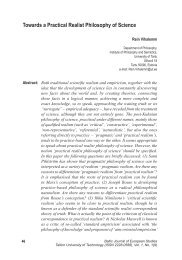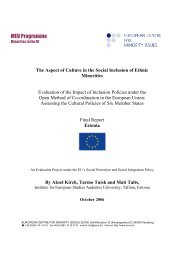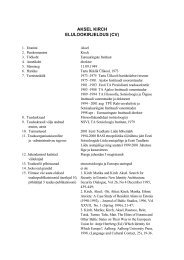Botanical Garden of the university of tartu (dorpat) - The Institute for ...
Botanical Garden of the university of tartu (dorpat) - The Institute for ...
Botanical Garden of the university of tartu (dorpat) - The Institute for ...
You also want an ePaper? Increase the reach of your titles
YUMPU automatically turns print PDFs into web optimized ePapers that Google loves.
Heldur Sander, Toivo Meikar<br />
Some outstanding persons and o<strong>the</strong>r contributors <strong>of</strong> plants<br />
Seeds were received on several occasions via Count Nikolai Petrovich<br />
Rumyantsev (1754–1826) (Tankler & Pullonen, 1994, p. 18), who may<br />
have dispatched plant seeds obtained from <strong>the</strong> round-<strong>the</strong>-world expedition<br />
<strong>of</strong> Adam Johann von Krusenstern in 1803–1806, and from Vassili Golovin’s<br />
round-<strong>the</strong>-world expedition in 1817–1819 with <strong>the</strong> participation <strong>of</strong> Ferdinand<br />
von Wrangell, as Rumyantsev was on very good terms with Krusenstern and<br />
Wrangell (Lundalin, 2011). <strong>The</strong> Imperial <strong>Garden</strong> <strong>of</strong> Pavlovsk (St Petersburg)<br />
received 270 tropical plant species in 1825 as a gift from Empress Maria<br />
Fyodorovna (supposedly via Weinmann) and a greenhouse was built <strong>for</strong> <strong>the</strong>m<br />
in <strong>the</strong> valley in <strong>the</strong> central part <strong>of</strong> <strong>the</strong> garden in 1825 (Siilivask, 1982, p. 186).<br />
In 1823, 215 accessions were received from London from Lieven, apparently<br />
from Christoph-Heinrich von Liewen (1774–1839), who was a Russian military<br />
general with Livonian roots, born in Kiev. He was <strong>the</strong> Russian ambassador to<br />
London in 1812–1834 and later <strong>the</strong> tutor <strong>of</strong> Russian Czar Alexander II. <strong>The</strong><br />
plants are likely to have been sent via him, although it is also possible that <strong>the</strong>y<br />
were sent by his wife Doro<strong>the</strong>a von Lieven (1785–1857), who was very well<br />
known in Europe <strong>for</strong> her beauty, extensive knowledge and a broad scale <strong>of</strong><br />
activities.<br />
James G. Booth from Hamburg was <strong>the</strong> son <strong>of</strong> Jacob James Booth (1760<br />
or 1770–1814), founder <strong>of</strong> <strong>the</strong> <strong>for</strong>mer famous nursery James Booth & Söhne<br />
(Booth & Sons). <strong>The</strong> nursery was founded jointly with Baron Kaspar von Voight<br />
(1752–1839) in 1795 at Flottbeck, near Hamburg, and operated until 1884(6).<br />
<strong>The</strong> nursery was mainly a distributor <strong>of</strong> <strong>the</strong> novelties <strong>of</strong> <strong>the</strong> day and represented<br />
an important mark in <strong>the</strong> history <strong>of</strong> German rose breeding. <strong>The</strong> nursery was also<br />
specialised in North American trees (Pontt & Dähren, 1845). Booth sent 226<br />
accessions in <strong>the</strong> years 1840, 1841, 1847–1850 (each year) and 1852 and 1853.<br />
Swiss botanist Alphonse de Candolle (1806–1893) sent 36 accessions in 1840<br />
from Geneva. Candolle initially studied law but graduated in botany and later<br />
succeeded to his fa<strong>the</strong>r’s chair at <strong>the</strong> University <strong>of</strong> Geneva. His fa<strong>the</strong>r, naturalist<br />
Augustin Pyramus de Candolle (1778–1841), was interested in botany in his<br />
youth, commenced medical studies in Geneva, continued his studies in medicine<br />
and natural history in Paris and was appointed as pr<strong>of</strong>essor <strong>of</strong> botany at <strong>the</strong><br />
Medical School in Montpellier and later in Geneva. His scientific research<br />
covered plant taxonomy, phytochemistry, plant pathology, medical botany,<br />
agronomy and phytogeography. A. de Candolle’s son was <strong>the</strong> botanist Casimir<br />
de Candolle (1836–1918).<br />
248<br />
Baltic Journal <strong>of</strong> European Studies<br />
Tallinn University <strong>of</strong> Technology (ISSN 2228-0588), Vol. 1, No. 1(9)



